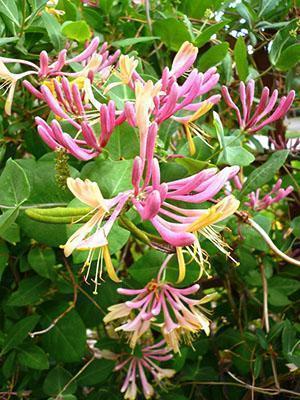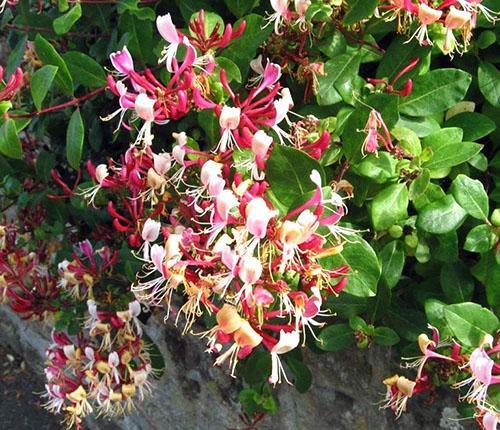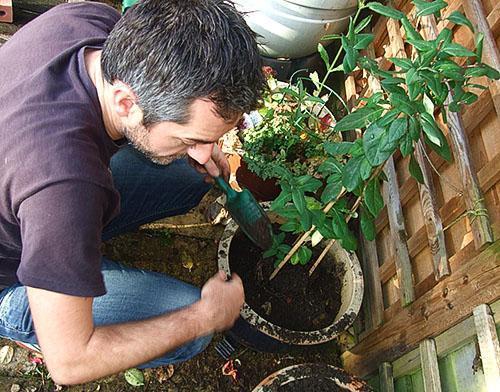Planting and caring for a honeysuckle plant
 Both fruiting shrubs of honeysuckle and ornamental plants of this species have been enjoying the attention of domestic gardeners for a century. The variety of types and forms of honeysuckle allows you to use the culture when decorating arches, as a hedge, in group and single plantings. Almost all honeysuckle shrubs are excellent honey plants. Varieties with healthy edible berries regularly delight with a bountiful harvest. How difficult is it to plant this shrub in your area? And how to care for honeysuckle, so that the plant will maximize all its qualities?
Both fruiting shrubs of honeysuckle and ornamental plants of this species have been enjoying the attention of domestic gardeners for a century. The variety of types and forms of honeysuckle allows you to use the culture when decorating arches, as a hedge, in group and single plantings. Almost all honeysuckle shrubs are excellent honey plants. Varieties with healthy edible berries regularly delight with a bountiful harvest. How difficult is it to plant this shrub in your area? And how to care for honeysuckle, so that the plant will maximize all its qualities?
Read also the article in the topic: Useful properties of honeysuckle.
Choosing a place for planting honeysuckle
Honeysuckle, whether it is a fruit shrub or a lush blooming liana, is distinguished by simple agricultural technology, does not require special painstaking care or conditions.

Honeysuckle requirements for soil composition are very modest. The shrub prefers loose, moderately moist soil with an acidity of up to 8.5 units. When planting honeysuckle, it is imperative that good drainage is provided, and as fertile soil, a mixture of three parts of sod land is quite suitable, peat and sand taken one piece at a time.
see also photo of honeysuckle Caprifol!
Planting honeysuckle on the site
Saplings with a root system protected by a clod of earth and a container can be planted in the garden from April to October, without fear that the plant will hardly acclimatize and get sick.
 The seedling, carefully transferred to the planting pit, is quickly accepted and does not require, except for feeding and watering, any special care measures. If honeysuckle with an open root system is to be planted, then the most favorable time for this is the period from the second half of August to October. This is due to:
The seedling, carefully transferred to the planting pit, is quickly accepted and does not require, except for feeding and watering, any special care measures. If honeysuckle with an open root system is to be planted, then the most favorable time for this is the period from the second half of August to October. This is due to:
- the end of the growing season;
- good winter hardiness of the bush;
- completion of the formation of shoots and apical buds for growth in the coming season.
 Since honeysuckle is a cross-pollinated plant, the gardener should provide for the presence of bushes somewhere nearby for the transfer of pollen by insects, otherwise it will not be necessary to wait for the harvest from the only bush on the site.
Since honeysuckle is a cross-pollinated plant, the gardener should provide for the presence of bushes somewhere nearby for the transfer of pollen by insects, otherwise it will not be necessary to wait for the harvest from the only bush on the site.
Plants of two or three years of age are most often used as planting material, for which pits are prepared at least 30 centimeters deep and wide.
 You can also transplant more mature plants. The only condition is that honeysuckle, like in the photo, which is planted and cared for already in the sixth year of life, should be preliminarily cut to 50 cm in height. Due to the absence of a large crown and a mass of foliage, this will make it easier for the bush to get used to new conditions.
You can also transplant more mature plants. The only condition is that honeysuckle, like in the photo, which is planted and cared for already in the sixth year of life, should be preliminarily cut to 50 cm in height. Due to the absence of a large crown and a mass of foliage, this will make it easier for the bush to get used to new conditions.
For pre-cut bushes 5–7 years old, the planting holes are widened and deepened to 50 cm:
- It is important to leave a distance of at least one and a half to two meters between seedlings that are to grow well.
- The root system is straightened and sprinkled with soil so that the root collar of the bush is at the level of the soil.
- The necessary fertilizers are introduced into the pit, for example, 40 grams of a potassium-containing agent, 60-100 grams of superphosphate and about five kilograms of mullein.
 If the soil is initially fertilized, the plant will not need additional fertilizing for two years after planting. And how is honeysuckle taken care of immediately when the seedling hits the ground?
If the soil is initially fertilized, the plant will not need additional fertilizing for two years after planting. And how is honeysuckle taken care of immediately when the seedling hits the ground?
- The planting site is thoroughly watered.
- The soil under the planted bush is mulched to prevent rapid evaporation of moisture.
Planting honeysuckle in spring is only possible if the plant enters the growing season late. Most often these are decorative species, for example, alpine or small-leaved honeysuckle. It is better not to disturb fruiting varieties in spring. Caring for honeysuckle, planting fell on the time of kidney revival and the beginning of growth, it threatens with serious complications.
On this topic:Tatar honeysuckle variety description!
How to care for honeysuckle?
 The growing season for honeysuckle begins in early spring. Plants quickly revive after winter and for abundant flowering they must receive high-quality fertilizing in the form of a universal fertilizer at the rate of 20-30 grams per meter of planting area. When the plant gives buds, it is good to support its strength by watering Kemira Universal, 20 grams per bucket of water.
The growing season for honeysuckle begins in early spring. Plants quickly revive after winter and for abundant flowering they must receive high-quality fertilizing in the form of a universal fertilizer at the rate of 20-30 grams per meter of planting area. When the plant gives buds, it is good to support its strength by watering Kemira Universal, 20 grams per bucket of water.
Honeysuckle responds favorably to sprinkling. This procedure, if there is a noticeable lag in the growth of the shrub, can be used to introduce foliar bait, which includes superphosphate, nitrogen and potash fertilizers. When summer is over, it is important that the plants hibernate strong and healthy.
How to feed honeysuckle in autumn?
- After a massive leaf fall, the soil under the honeysuckle bushes is loosened by 20 cm and 100-200 grams of sifted wood ash is applied per meter of plantation.
- In addition, the shrubs should be fed with infusion of manure or humus with the addition of phosphorus and potassium fertilizers.
- Before the onset of cold weather, the trunk circles under the plants are covered with peat or sawdust, with a layer of up to 5 cm.
To get berries with decent taste, it is not enough to plant a high-yielding variety on the site. It is necessary to provide the plant with sufficient watering and monitor the condition of the soil under the plantings.
How to care for honeysuckle during the hot season? Honeysuckle does not have a great need for water, but in hot dry weather, especially with ripening berries, additional watering of 10 liters per bush is necessary. Otherwise, the soil dries up and becomes compacted.
Plants that do not receive moisture are forced to either shed some of the fruits, or the berries ripen dry with a clear bitter aftertaste.
Honeysuckle pruning and shrub formation
 Caring for honeysuckle in the fall is not limited to fertilizing and loosening the soil. After the completion of the leaf fall, it is time to trim the shrub. Depending on the type of plant and its purpose, the formation of the crown proceeds in different ways. Ornamental vines and plants planted for the purpose of creating hedges need only sanitary removal of weak, diseased and damaged branches, as well as shaping the bush. In fruiting honeysuckle, not only the appearance, but also the number of ripe berries depends on the quality of the pruning. Therefore, pruning such plants has its own characteristics.
Caring for honeysuckle in the fall is not limited to fertilizing and loosening the soil. After the completion of the leaf fall, it is time to trim the shrub. Depending on the type of plant and its purpose, the formation of the crown proceeds in different ways. Ornamental vines and plants planted for the purpose of creating hedges need only sanitary removal of weak, diseased and damaged branches, as well as shaping the bush. In fruiting honeysuckle, not only the appearance, but also the number of ripe berries depends on the quality of the pruning. Therefore, pruning such plants has its own characteristics.
 The best time to prune honeysuckle is in autumn, when the foliage has fallen, and the structure of the bush is well traced. The movement of juices in honeysuckle begins very early, if you do not have time to remove excess or old branches in March, you will have to wait until October. But dry shoots can be removed at any time. Honeysuckle for the first two or three years of life does not need much pruning. The development of shoots at this time is due to the upper buds, and the bush increases the green mass. Then the elongation of the branches gradually stops, and they begin to overgrow with lateral branches.
The best time to prune honeysuckle is in autumn, when the foliage has fallen, and the structure of the bush is well traced. The movement of juices in honeysuckle begins very early, if you do not have time to remove excess or old branches in March, you will have to wait until October. But dry shoots can be removed at any time. Honeysuckle for the first two or three years of life does not need much pruning. The development of shoots at this time is due to the upper buds, and the bush increases the green mass. Then the elongation of the branches gradually stops, and they begin to overgrow with lateral branches.
It is generally accepted that from the age of 3, a properly formed young bush practically does not need any intervention in its growth.
 But if initially the plant had more than five zero-level shoots extending from the root, you will have to cut out the extra branches earlier. If this is not done, the shoots will start to weaken and dry out on their own from the lack of light. Removal and pruning on honeysuckle in the fall are subject to:
But if initially the plant had more than five zero-level shoots extending from the root, you will have to cut out the extra branches earlier. If this is not done, the shoots will start to weaken and dry out on their own from the lack of light. Removal and pruning on honeysuckle in the fall are subject to:
- powerful tops on branches that have slowed down or have already stopped growing;
- growth coming from the base of the bush;
- short, weak shoots that do not have time to ripen for winter;
- diseased, dry and damaged branches.
Mass fruiting in honeysuckle occurs on strong one-year-old shoots, so they cannot be shortened. When pruning a photophilous crop, the main attention is paid to the branches directed deep into the crown. They interfere with the growth of neighboring shoots, interfere with pollination and the development of berries. They are cut out first.
 How and when to prune honeysuckle, if an adult bush gives less and less yields? From eight to ten years of age, honeysuckle ages and needs rejuvenating pruning, including:
How and when to prune honeysuckle, if an adult bush gives less and less yields? From eight to ten years of age, honeysuckle ages and needs rejuvenating pruning, including:
- severe crown thinning,
- cutting out all branches weakened by pests or diseases;
- removal of old branches and their replacement with tops or branches located near the base of the bush;
- cut off branches that have stopped growing to transfer to strong branches or tops located closer to the base of the bush.
- pruning dry branches to live, undamaged tissue.
Places of cuts of large branches must be treated with garden pitch. If the bush is running, and thinning is not possible, it is worth removing the entire crown above 50 cm from the root collar in order to start the formation of honeysuckle again from the next season.
Read also the article: honeysuckle - planting and care in the suburbs!